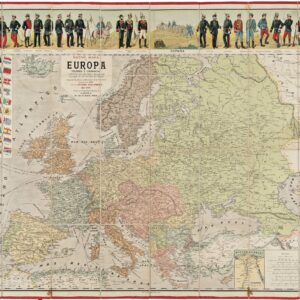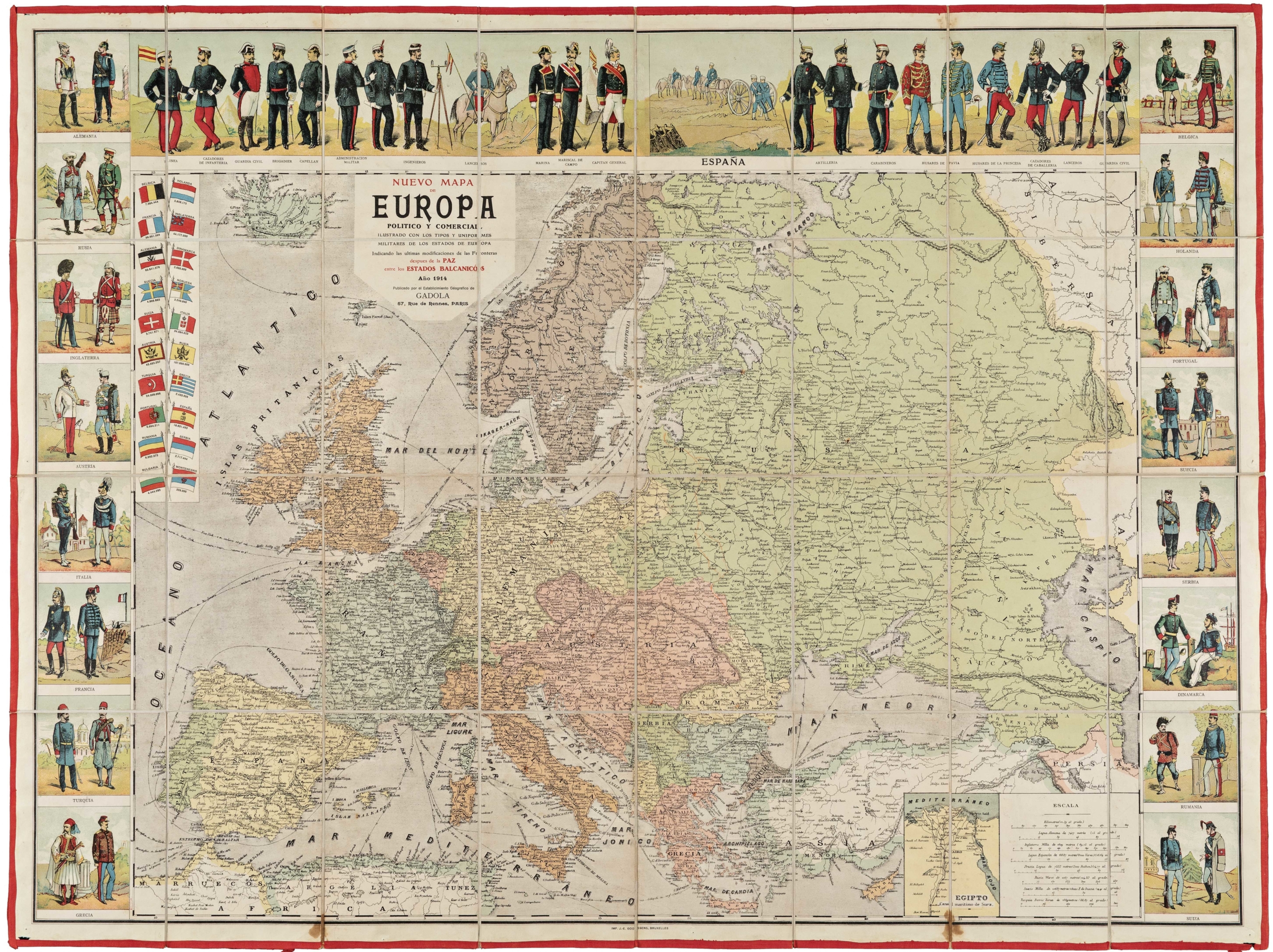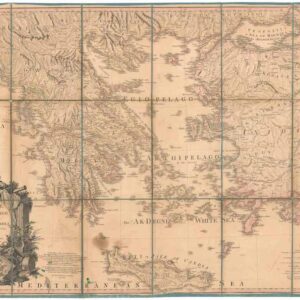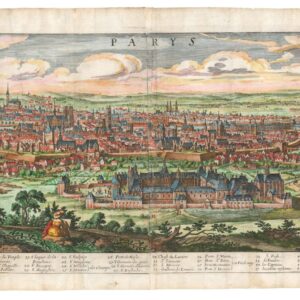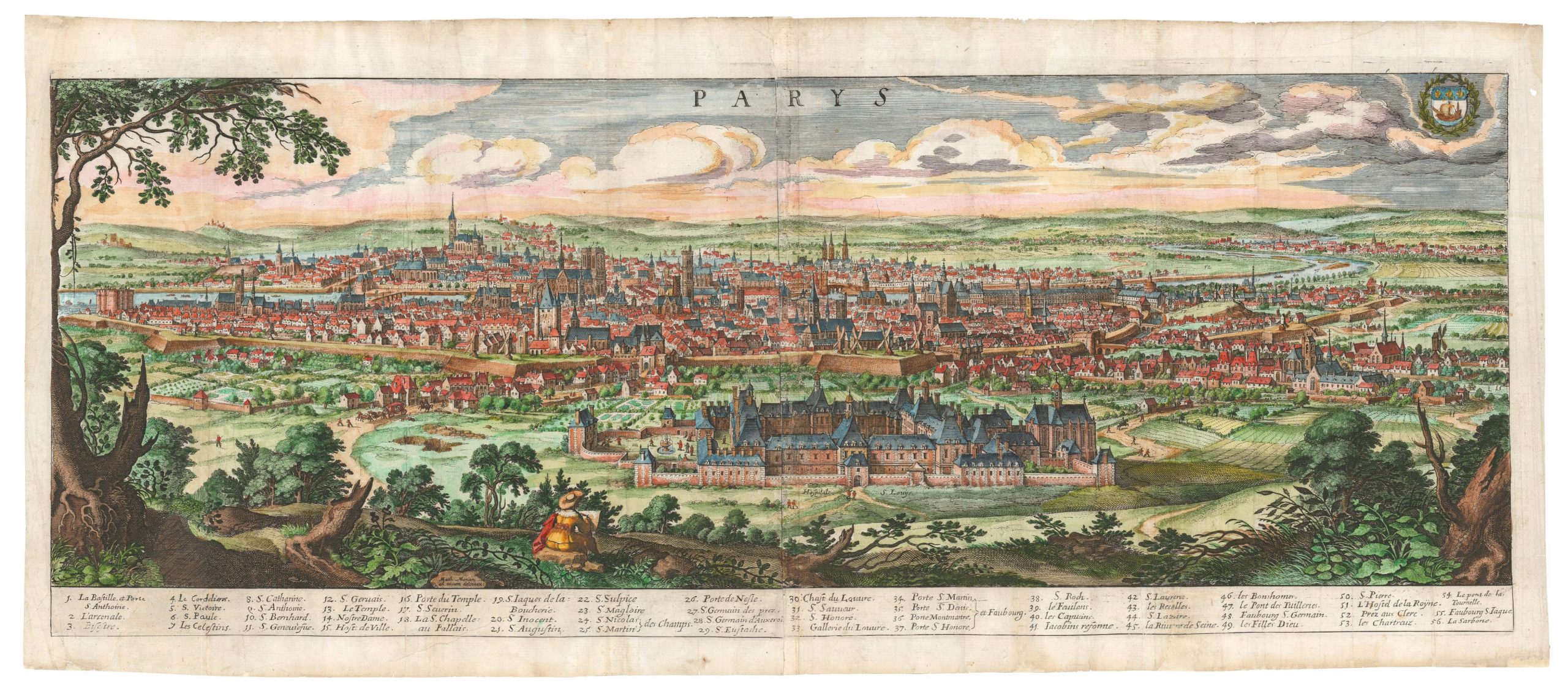Full-color example of Europe as a Queen.
[Europe as a Queen]
Out of stock
Description
A nice full color example of Münster’s iconic representation of Europe in the shape of a queen. The map depicts Europe in the form of a queen with select cities, river, and mountain ranges. Labels are done in partial letterpress.
Meurer outlines the basic geography:
The crowned head represents the Iberian Peninsula; the right ear is Aragon and the left ear Navarra.
France is the chest.
The Alps and the river Rhine are two necklaces. On the Rhine is hanging a chain with a great golden coin or jewel representing the mountain ring of Bohemia.
Germany is the heart of Europe.
Italy forms the right arm, the imperial orb in the right hand is Sicily.
The left arm, which clutches a scepter, is Denmark.
Along the lower border of the queen’s skirt are arranged Greece with the Peloponnesus (on her right) and the Baltic lands up to Muscovy (on her left).
Constantinopel and Prussia are said to represent the two feet.
The river Danube and the “Albanian mountains” (the Balkans) are two long precious chains hanging from the queen’s belt.
The Appenine mountains run the length of the right arm (Italy).
The Dneiper, Done, Rhône, and Sava rivers are shown.
Representations of Europa Regina are among the most sought-after anthropomorphic maps available to collectors. The conceptualization of Europe as a female figure is an antique myth that comes from many sources and in many versions, but its origins are most famously associated with the Phoenician princess Europa in Ovid’s Metamorphoses. In the poem, Zeus lusts after Europe, transforming himself into a white bull and abducting her. He takes her to Crete, where she becomes the island’s first queen and gives birth the king Minos.
The symbolism and use of the myth of Europa Regina changed over time, eventually linked to the struggle between the Christian Occident and Muslim Orient. The first known cartographic expressions of Europe as a Queen in map form date to the 16th century, when the House of Habsburg was engaged in conflict with the Ottoman Empire; Charles of Habsburg, who during his life time was crowned King of Spain, King of Germany, and Holy Roman Emperor, personally led a campaign to recapture Tunis in 1535. Two years later, the first printed anthropomorphic map was published in Paris, the work of the Tyrolean poet and courtier, Johannes Putsch.
Cartographer(s):
Sebastian Münster (1488-1552) was a cosmographer and professor of Hebrew who taught at Tübingen, Heidelberg, and Basel. He settled in Basel in 1529 and died there, of the plague, in 1552. Münster was a networking specialist and stood at the center of a large network of scholars from whom he obtained geographic descriptions, maps, and directions.
As a young man, Münster joined the Franciscan order, in which he became a priest. He studied geography at Tübingen, graduating in 1518. Shortly thereafter, he moved to Basel for the first time, where he published a Hebrew grammar, one of the first books in Hebrew published in Germany. In 1521, Münster moved to Heidelberg, where he continued to publish Hebrew texts and the first German books in Aramaic. After converting to Protestantism in 1529, he took over the chair of Hebrew at Basel, where he published his main Hebrew work, a two-volume Old Testament with a Latin translation.
Münster published his first known map, a map of Germany, in 1525. Three years later, he released a treatise on sundials. But it would not be until 1540 that he published his first cartographic tour de force: the Geographia universalis vetus et nova, an updated edition of Ptolemy’s Geography. In addition to the Ptolemaic maps, Münster added 21 modern maps. Among Münster’s innovations was the inclusion of map for each continent, a concept that would influence Abraham Ortelius and other early atlas makers in the decades to come. The Geographia was reprinted in 1542, 1545, and 1552.
Münster’s masterpiece was nevertheless his Cosmographia universalis. First published in 1544, the book was reissued in at least 35 editions by 1628. It was the first German-language description of the world and contained 471 woodcuts and 26 maps over six volumes. The Cosmographia was widely used in the sixteenth and seventeenth centuries and many of its maps were adopted and modified over time, making Münster an influential cornerstone of geographical thought for generations.
Condition Description
Very good.
References
Peter Meurer, "Europa Regina. 16th century maps of Europe in the form of a queen." Belgeo, 3-4 | 2008, 355-370.

